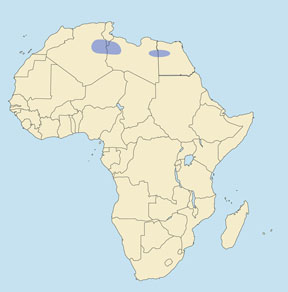 |
Gazella leptoceros
Gacela de Loder (Sp), Dünengazelle (G), Gazelle leptocère, Rhim (F). Also called African sand gazelle or white gazelle or rhim (Arabic). It should be noted that the name rhim is also applied by local people in Arabia and the Middle East to the Arabian goitered gazelle (Gazella subgutturosa marica).
Often called Loder gazelle; however, that name probably should apply only to the subspecies loderi of Algeria and Tunisia, which was named for Sir Edmond G. Loder, its European discoverer in 1894.
DESCRIPTION Shoulder height 25-28 inches (64-71 cm). Weight 55-65 pounds (25-30 kg).
A smaller gazelle, very pale, with the usual gazelle markings barely discernible. The general color is a pale sandy fawn. On the face, the median blaze and lateral stripes are sandy, contrasting only slightly with the white stripes. The flank bands and pygal (rump) stripes are only a little darker than the back. The ears are very long, narrow and pointed, and their backs are whitish buff. The tail is sandy, with a brownish black fringe at the tip. The hoofs are long, narrow and splayed, in an adaptation for travel in fine sand. Horns (both sexes) are long and slender, closely and heavily ringed almost to the tip, and relatively straight, curving only slightly backward, although sometimes diverging widely. Females are similar to males, but with horns that are slimmer and straighter.
BEHAVIOR Lives in pairs or small family groups. Breeds May-June with one young born after 5 to 5-1/2 months gestation. Longevity as much as 14 years.
Active mainly early and late in day. Feeds on grasses and desert plants. Obtains moisture from food and dew. Eyesight, hearing and sense of smell are very good. The slender-horned gazelle is a true desert species that utilizes country in which few other animals could exist. Its large, splayed hoofs permit it to travel in deep sand where enemies cannot follow; however, on firm ground it is easily run down by horsemen or motor vehicles.
HABITAT True desert.
DISTRIBUTION The Sahara Desert in Algeria, Tunisia, Libya, and Egypt west of the Nile. May still exist in northern Chad and northwestern Sudan.
TAXONOMIC NOTES Two subspecies: leptoceros (western desert in Egypt), with a comparatively small body and darker coloration, but very long horns; and loderi (Loder gazelle of eastern Algeria and adjacent parts of Tunisia), larger, with lighter coloration, narrower skull and shorter horns.
STATUS Listed as endangered by the IUCN and the USF&WS (1970). It once was the most common gazelle in the Sahara region and was abundant in those parts of the desert with enough vegetation to support it. Now rare because of overshooting by local Arabs.
|





